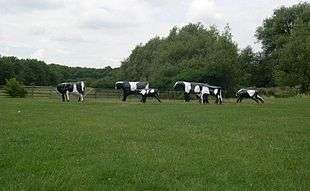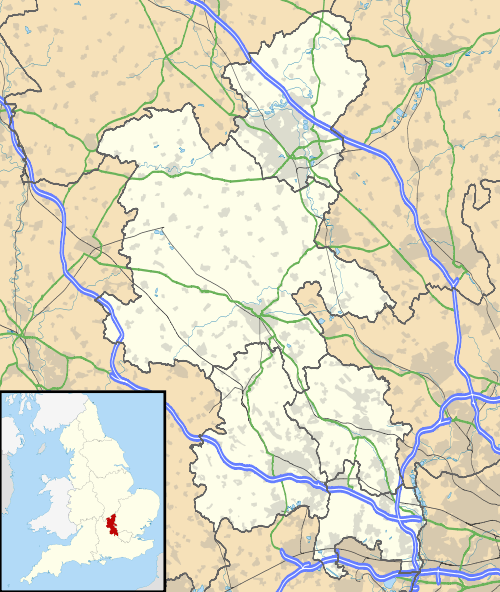Stantonbury
Stantonbury is a district and civil parish of Milton Keynes, Buckinghamshire, England,[2] north of Central Milton Keynes, between Great Linford and Wolverton, and south of Oakridge Park. It is largely residential, but the greater proportion of the area is taken up by two secondary schools (Stantonbury Campus and the Webber Independent School), a leisure centre with a 25m swimming pool, and an all-weather, competition standard, athletics track.
| Stantonbury | |
|---|---|
 Liz Leyh's Concrete Cows | |
 Stantonbury Mapping © OpenStreetMap  Stantonbury Location within Buckinghamshire | |
| Population | 10,084 (2011 Census)[1] |
| OS grid reference | SP847414 |
| Civil parish |
|
| Unitary authority |
|
| Ceremonial county | |
| Region | |
| Country | England |
| Sovereign state | United Kingdom |
| Post town | MILTON KEYNES |
| Postcode district | MK14 |
| Dialling code | 01908 |
| Police | Thames Valley |
| Fire | Buckinghamshire |
| Ambulance | South Central |
| UK Parliament | |
Modern Stantonbury lies on land (known as "Stanton High", as opposed to "Stanton Low" – near the River Great Ouse) – the deserted village of historic Stantonbury,[3] one of the former Buckinghamshire villages that were included in the area designated in 1967 to become Milton Keynes. The toponym is derived from an Old English term for "fortified building by a farm on stony ground".
Parish church
The former Church of England parish church of Saint Peter in Stanton Low is Norman, with a mid-12th century nave and even earlier chancel.[3] There was a squint in the south wall of the chancel, but this was later blocked.[3] St. Peter's was extensively rebuilt in the 13th century; the Decorated Gothic east window and piscina were added in the 14th century.[3] By the latter part of the 17th century Stantonbury was an almost deserted village, but the church was still in use; between 1668 and 1674 the Puritan poet and hymnwriter John Mason was its parish priest.[3] In 1736 only four houses remained in the village,[3] but St Peter's was still in use in 1927[3] and John Piper painted a watercolour of it in about 1940.[4] By 1955 the church had been disused for a number of years; the following year the roof collapsed[5] and was not repaired. By 1973 St. Peter's was a ruin, and the east window and ornamented Norman chancel arch had been removed.[6]
Civil parish
As well as Stantonbury itself, the civil parish of Stantonbury includes the districts of Bancroft and Bancroft Park, Blue Bridge, Bradville and Linford Wood. The population of the parish of Stantonbury grew from 19 at the 1971 census to 3,938 according to the 1981 census. By the time of the 2001 census its population had reached 9,010.[7] At the 2011 census, it had 10,084 people.[1]
Bancroft
The residential Bancroft district is divided by Shenley Brook into Bancroft Park to the north and Bancroft to the south. The brook valley here is part of the flood control system and there is a permanent wetland with associated plants and wildlife.
- Bancroft Park
The foundations of a Romano-British farm known as Bancroft Roman Villa are in what is now the North Loughton Park, overlooking the Shenley Brook.[8] Rescue excavations in 1957 identified a group of perhaps four buildings, traces of a hypocaust and sherds of Iron Age pottery.[6]
A copy of the famous Concrete Cows sculpture is at the southern end of the park (the original is in the Milton Keynes Museum).
Bancroft is a haven for birds and one of the best places to see a common kingfisher. This is because of the wide variety of habitats the Parks Trust has created, from old grassland managed as wildflower meadows, through patches of thorn scrub to extensive marsh. cowslips and salad burnet flower in the spring, followed in summer to the customary flowers of traditional hay meadow: lady's bedstraw and birdsfoot trefoil.
Bancroft pétanque Piste, which is near the Roman villa site, is provided by the Parks Trust free of charge. Also known as boules, pétanque is a traditional game played with steel balls on any sandy or gravelly surface across a large part of Europe.
The Bancrofts comprise just half the H2/H3/V5/V6 grid square, which is divided by the West Coast Main Line; the line is also the parish boundary, with Stacey Bushes (in Wolverton and Greenleys parish) on the other side of the tracks. Monks Way (H3, A422) bounds the parish from the neighbouring Bradwell.
Blue Bridge
This small district is mainly residential, near the West Coast Main Line and the Grand Union Canal (which separates it from Stonebridge, the rest of the grid square). It is also home to its own residential club, which it shares with Bancroft Park.[9]
Bradville
This district, between Bradwell, New Bradwell and Stantonbury itself, is mainly residential.
Linford Wood
As well as the ancient woodland, this district is mainly for high-tech industry. It is best known in Milton Keynes as the site of the telecommunications tower, for which it was chosen for its high elevation. It was originally part of the Linford demesne.
Oakridge Park
This small district of private housing development, part of the northern expansion of Milton Keynes outside its 1967 designated boundary, dates from about 2010. There is a small local centre with an Asda supermarket, a pharmacy and other small shops.
Stanton Low
Today this is an uninhabited agricultural area near the river Great Ouse. Little if anything remains of the deserted village other than the ruins of the parish church of St Peter (see above). In the late 1950s the ruins of a Roman villa were discovered here, but were completely destroyed by gravel extraction.[10]
Demography
| Stantonbury compared | |||
|---|---|---|---|
| 2001 UK Census | Stantonbury ward | Milton Keynes UA | England |
| Population | 8,940 | 207,057 | 49,138,831 |
| Foreign born | 9.8% | 9.9% | 9.2% |
| White | 89.6% | 90.7% | 90.9% |
| Asian | 5.2% | 4.5% | 4.6% |
| Black | 3.2% | 2.4% | 2.3% |
| Christian | 64.2% | 65.5% | 71.7% |
| Muslim | 2.6% | 2.3% | 3.1% |
| Hindu | 1.9% | 1.3% | 1.1% |
| No religion | 22.2% | 21.6% | 14.6% |
| Unemployed | 3.5% | 3% | 3.3% |
| Retired | 9.2% | 9% | 13.5% |
At the 2001 UK census, the Stantonbury electoral ward had a population of 8,940. The ethnicity was 89.6% white, 1.5% mixed race, 5.2% Asian, 3.2% black and 0.5% other. The place of birth of residents was 90.2% United Kingdom, 1.1% Republic of Ireland, 1.4% other Western European countries, and 7.3% elsewhere. Religion was recorded as 64.2% Christian, 0.3% Buddhist, 1.9% Hindu, 0.7% Sikh, 0.2% Jewish, and 2.6% Muslim. 22.2% were recorded as having no religion, 0.6% had an alternative religion and 7.4% did not state their religion.[11]
The economic activity of residents aged 16–74 was 50.8% in full-time employment, 11.6% in part-time employment, 6.3% self-employed, 3.5% unemployed, 3% students with jobs, 2.6% students without jobs, 9.2% retired, 5.8% looking after home or family, 4.7% permanently sick or disabled and 2.6% economically inactive for other reasons. The industry of employment of residents was 22.3% retail, 15.4% manufacturing, 5.1% construction, 15% real estate, 6.4% health and social work, 6.6% education, 10.8% transport and communications, 4.6% public administration, 3.9% hotels and restaurants, 5.2% finance, 0.5% agriculture and 4.2% other. Compared with national figures, the ward had a relatively high proportion of workers in retail, transport and communications. There were a relatively low proportion in construction, health and social work, and agriculture. Of the ward's residents aged 16–74, 15% had a higher education qualification or the equivalent, compared with 19.9% nationwide.[11]
References
- UK Census (2011). "Local Area Report – Stantonbury (E04012191)". Nomis. Office for National Statistics. Retrieved 17 November 2019.
- Parishes in Milton Keynes Archived 8 June 2009 at the Wayback Machine – Milton Keynes Council.
- "Parishes: Stantonbury" Victoria History of the Counties of England, A History of the County of Buckingham: Volume 4 (1927), pp. 462–466.
- "Bradwell & Stantonbury". Wolverton Past – History before 1970. Blogspot. Retrieved 29 September 2012.
- "More on Stantonbury". Wolverton Past – History before 1970. Blogspot. Retrieved 29 September 2012.
- Pevsner 1973, p. 241.
- Population Bulletin 2005/06, page 22
- Williams, R.J.; Zeepvat, R. (1994). A late Bronze Age/Iron Age Settlement, Roman Villa and Temple/Mausoleum. Monograph. 7. Aylesbury: Buckinghamshire Archaeological Society.
- Roman Park Residents Club (Facebook page)
- Historic England. "Monument No. 345100". PastScape. Retrieved 2 June 2019.
- "Neighbourhood Statistics". Office for National Statistics. Retrieved 20 April 2008.
Sources
- Page, W.H., ed. (1927). A History of the County of Buckingham, Volume 4. Victoria County History. pp. 462–466.
- Pevsner, Nikolaus (1973) [1960]. Buckinghamshire. The Buildings of England. Harmondsworth: Penguin Books. p. 241. ISBN 0-14-071019-1.CS1 maint: ref=harv (link)
External links
- Stantonbury Brass
- Leisure centre
- Milton Keynes Fencing Club
- City of Milton Keynes Swimming Club
- Running track